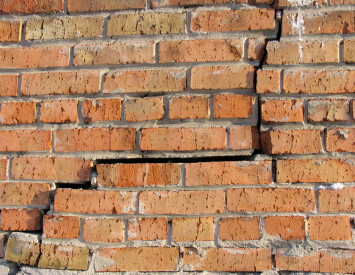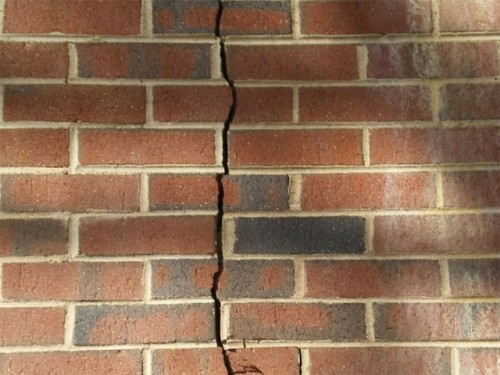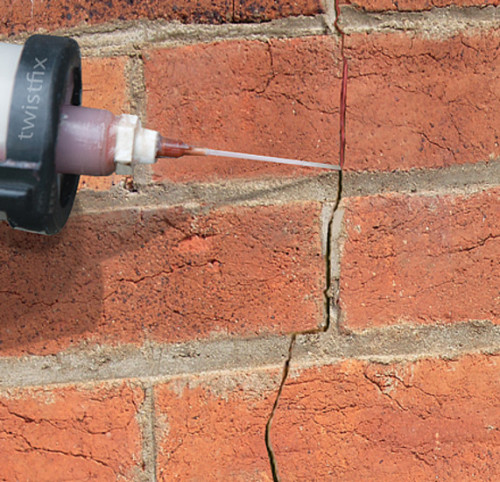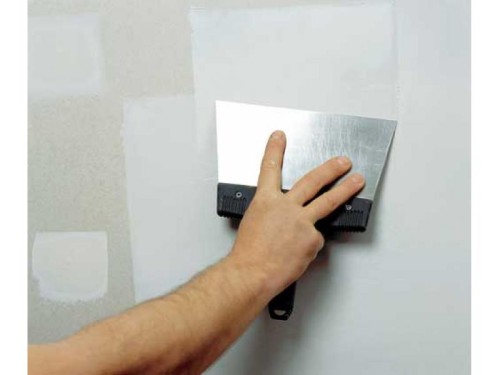A crack in the wall is a problem that residents face both private and apartment buildings. This defect is able to entail a violation of the integrity of the finish. For example, showing paint or peeling of wallpaper. Therefore, this situation cannot be ignored, regardless of the size of the crack.
Content
How to make a crack in a brick wall
Damage to brickwork occurs for the following reasons:
- The soil having a heterogeneous structure after a certain time settles. This leads to the appearance of cracks.
- The same consequences have deformation changes in the foundation that are formed in case of insufficient deepening or placement near groundwater and increased load on the walls from ceilings. For 12 months after the construction, the building is shrinkable, which also provokes the formation of cracks.
- Problems may also occur if the styling technology does not meet the established requirements. As well as when using a poor -quality solution.
You can determine the cause by localizing the problem:
- cracks in the lower part of the building indicate excessive overlap pressure;
- the upper part is damaged as a result of the settlement of the foundation base.
Before shaking cracks in a brick wall, you need to make sure that they do not increase in size. In the opposite case, the work done will be unsuccessful. Paper landmarks should be attached to the wall and follow their integrity.
To eliminate a small crack up to 5 mm wide, you can use the cement composition. Work is carried out in the following sequence:
- Initially, you need to remove the garbage from the gap and process it from the inside with a moistened rag.
- The edges of the gap before work should be knocked down with a hammer, because This will ensure better adhesion of the solution and bricks.
- Damage to medium sizes (from 5 mm to 10 mm) is also eliminated using a cement composition, but with the addition of an additional component - sand.
Cracks, the width of which exceeds 10 mm, are critical. The lack of timely intervention may have negative consequences. Eliminated such damage can be eliminated by several methods:
- The damaged area should be disassembled and replaced with new material.
- The masonry is disassembled from the upper row. Bricks are laid according to the “brick lock” method.
- Fragments of reinforcement are inserted into the masonry, which overlap the crack.
- If there is no opportunity to disassemble the masonry, the place of damage is sealed with a solution of cement.
- You can drive T-shaped metal elements into the gap, which are fixed on both sides using dowels. The use of metal parts is not mandatory. But in this case, the wall of the building must be strengthened from the inside.
- Cracking of cracks in the walls of brick can be carried out through mounting foam or sealing agents. The gap cavity should be filled with foam, wait until it froze and cut the material to a depth of 2 cm.
- The formed space is filled with a cement mixture. When using a sealant, it is important to choose the right composition. Do not use a sealing agent based on silicone, since this material does not have adhesion with plaster, putty and paint.
- It is necessary to prepare a special sealant for processing seams. It is placed in the gap through a construction pistol. The sealant for cracks in the wall has a certain advantage over the cement mixture. It has the ability to increase and decrease in size without the formation of cracks, which is an unusual usual solution. This tool belongs to the category of expensive materials, but its use allows you to get a quality result.
- It is recommended to strengthen the cracked wall from the inside. This procedure provides for the sealing of the damaged area and the imposition of a metal profile, which will play the role of the lock. It should be placed on a crack in order to prevent its subsequent distribution. Anchors are used to fix this element. Steel brackets can be used. In this case, you need to pre -drill holes.
- If the cracks are formed due to an incorrectly flooded foundation base, it is recommended to install an additional concrete belt on it. Along the perimeter of the house, you need to prepare a trench, the depth of which should exceed the depth of the foundation. Concrete is placed in this recess from which the belt is built.
How to eliminate cracks in a wall covered with a plaster mixture
The danger of cracks on the plastered walls is not limited only to aesthetic defect. Due to damage, both plastering coating and masonry may suffer. This mainly applies to the outer walls, where the decoration is largely subjected to the negative effects of low temperatures and moisture. Through the cracks in the coating, moisture penetrates into the masonry, in which it subsequently freezes. This becomes the cause of the lag and the destruction of masonry.
These damage to the plaster layer can form not only from the outer, but also from the inside of the house. These are very thin cracks that visually resemble a web and spread over the entire surface of the wall. The reason for this may be the incorrect application of the composition, violations in the proportions when mixing the components and failure to comply with the requirements for the care of the coating. Among the most common errors, the thick layer of the solution can be highlighted. Cracks in this situation are a natural consequence of technology violations.
Damage also appears after finishing: gluing wallpaper, staining or putty. This can be prevented using reinforcing elements that are installed before finishing. For this purpose, several materials are used:
- plaster mixture;
- fiberglass mesh;
- glass wallpaper;
- glassholst.
The most convenient option is the last material. The glass hub is attached to a primed and dry surface using a special adhesive composition designed to fix the steel. After completion of work, this material can be covered with finish putty or paint.
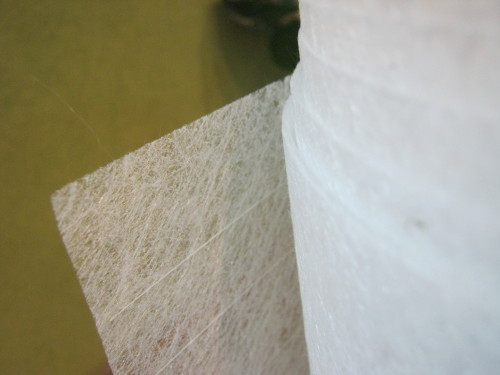
The plaster mixture is divided into 2 types:
- for processing internal surfaces;
- for external walls.
These types of plaster are distinguished by the components that make up their composition. For exterior decoration, the solution is prepared on the basis of cement, and lime compositions are considered more suitable for internal work.
To eliminate cracks using the plaster composition, you need to prepare:
- capacity;
- stem;
- graters of various sizes;
- brush for plastering;
- brush;
- kelm;
- water.
The plaster solution can be made independently or purchased in the finished form. In the process of home preparation, it is necessary to monitor the consistency, because Too liquid plaster will be poorly held. The process of finding cracks looks like this:
- Using the brush, the composition is applied to the damaged area, then leveled with a wooden grater.
- If the plaster on the wall was applied by spraying so that the processed area does not differ, you need to dip in the water and make patting movements on the surface.
- The easiest way to eliminate shrinkage microcracks. They need to be treated with deep impregnation, which penetrates the structure of the coating and strengthens it. Then the cracks can be painted over with dispersion paint.
A solution for cracks in a wall covered with a plaster composition should contain fillers and a binder. As a given element, construction gypsum, cement or construction lime can be used. The most durable is cement material. The indicators of its strength can be determined by labeling; for solutions, a brand 400 is used.
Construction gypsum will make the mixture more durable. This component accelerates the setting of the composition. It has a distinctive feature - it does not give shrinkage. Construction lime is used for external work, since it dries only in the air.

How to smear cracks in the wall of drywall
Damage in drywall material is formed due to several reasons:
- The most common is a violation of the technology when installing the frame and mounting sheets.
- The appearance of cracks can be triggered by improper putty and sealing the seams between the sheets.
- The causes of damage include sharp temperature changes in the room, an increased level of humidity and contact with water.
Gypsum cardboard does not differ in good resistance to moisture. When interacting with this factor, the sheets are deformed and retain this shape after drying. The only solution in this situation is to replace the material. You can get rid of cracks in drywall with two methods.
- The first option involves filling the cracks with putty or acrylic.
- The second method consists in gluing on top of the damaged area of \u200b\u200bthe fiberglass. Then the surface needs to be subsided, after which you can proceed to the finishing coating.
The surface processing process looks like this:
- Before filling the crack in the wall of the house, using the putty composition, it is necessary to remove the layer of plaster from the damaged area.
- Further, dust is removed through the vacuum cleaner.
- Then you need to prepare a putty mixture in the following proportions: on 2 parts of the powder 1 part of the liquid.
- The resulting mass is applied with a layer of 2 mm using a spatula.
- In addition to the crack, the nearest site should be processed.
- When using a reinforced tape, it must be placed in the gap and covered with putty composition.
- The putty dries for 1.5 hours.
- Then it is recommended to clean it and remove dust from the wall.
Clothing in a concrete wall
The main reason for the appearance of defects in the concrete wall is a violation of the ratio of cement and water in the preparation of cement-concrete composition. In the process of laying the solution, it must be thoroughly compacted by means of vibrators. Failure to comply with the emergence of cracks can lead to the appearance of cracks. It is recommended to cover fresh concrete with fabric to prevent excessive evaporation of moisture.
Of particular danger is the presence of cracks in the wall, which abides in conditions of frequent temperature differences. At low temperatures, the moisture enters the crack cavity, freezes and thereby increases the defect. The damage reaches the reinforcement, the corrosive process begins, which negatively affects the strength of the building. In order to timely detect defects, the structure must be regularly inspected. This will make it possible to eliminate cracks in the walls at the initial stage of development. You can not ignore even minor defective changes in concrete material.
So, it will take:
- hammer;
- chisel;
- grinding machine;
- spatula;
- metal brush;
- brush;
- vacuum cleaner;
- rake from wood material;
- trowel;
- water, sand, cement;
- adhesive;
- wire fragments;
- glade.
The workflow occurs in the following sequence:
- Using a hammer and a chisel, the crack needs to be broken to a depth of 5 mm. This will help prevent the loss of the repair composition.
- Next, the damaged place is cleaned of dust and moistened. Using a sponge, you need to remove excess moisture.
- If the reinforcement is visible, it must be treated with an anti -corrosion agent.
- The mixture is prepared on the basis of sand and cement, a ratio of 3: 1. You can add PVA to the composition.
- If the defects are deep, they should be filled in stages, moistening each layer of repair mixture.
- If necessary, the crack is reinforced with wire fragments.
- Then the surface must be leveled, for this the ironer is used.
- After hardening the composition, the protruding zones are adjusted using a grinding machine.
Conclusion
When planning the repair of walls, the sealing of cracks should become a prerequisite. This defect not only negatively affects the appearance of the building, but also threatens its strength. Today, the walls of houses are built from various materials, each of which requires an individual approach when eliminating cracks.
How to make a crack in the wall. Video:
